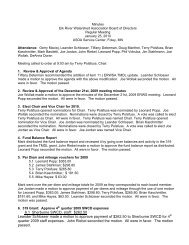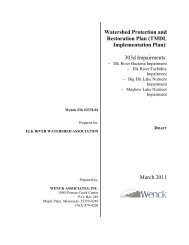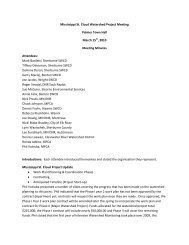Fungal Leaf Spot Diseases - Integrated Pest Management at the ...
Fungal Leaf Spot Diseases - Integrated Pest Management at the ...
Fungal Leaf Spot Diseases - Integrated Pest Management at the ...
- No tags were found...
You also want an ePaper? Increase the reach of your titles
YUMPU automatically turns print PDFs into web optimized ePapers that Google loves.
eport onPLANTDISEASERPD No. 648July 1998DEPARTMENT OF CROP SCIENCESUNIVERSITY OF ILLINOIS AT URBANA-CHAMPAIGNFUNGAL LEAF SPOT DISEASES OF SHADE ANDORNAMENTAL TREES IN THE MIDWESTAll shade trees are <strong>at</strong>tacked by one or more fungith<strong>at</strong> cause sc<strong>at</strong>tered, r<strong>at</strong>her definite, round to oval,angular, or irregularly shaped spots on <strong>the</strong> leaves(Figure 1). These spots usually become conspicuousfrom l<strong>at</strong>e June through August. <strong>Leaf</strong>spots are <strong>the</strong> most common diseases of shade andornamental trees. Most of <strong>the</strong>se diseases arefavored by cool we<strong>at</strong>her, light and frequent rains,fog or heavy dews, high humidity, and crowded orshady plantings.A few spots on <strong>the</strong> leaves do little harm to a treeand are far more unsightly than <strong>the</strong>y are injurious.However, leaf spot infections th<strong>at</strong> start early in <strong>the</strong>growing season can lead to prem<strong>at</strong>ure defoli<strong>at</strong>ion.If it occurs over two or more successive years, itFigure 1. Phyllosticta <strong>Leaf</strong> <strong>Spot</strong> on silver maple. Notesymptoms as described in Table 1 (courtesy Donald G. White, Uof IL).can seriously weaken a tree, reduce its growth, and increase its susceptibility to bark borers, winter injury,and o<strong>the</strong>r diseases. <strong>Leaf</strong> spots commonly increase in number and size in l<strong>at</strong>e summer and early autumnas <strong>the</strong> leaves begin to senesce. The occurrence of a leaf spot disease l<strong>at</strong>e in <strong>the</strong> growing season generallydoes not seriously affect <strong>the</strong> health of a tree. Certain leaf spots have special names, such as anthracnose,black spot, downy spot or white mold, ink spot, spot anthracnose, leaf blister or curl, scab, shot-hole,sooty blotch, and tar spot.SymptomsMost leaf spot diseases develop as small, sc<strong>at</strong>tered, circular to oval dead areas in <strong>the</strong> leaves; usually tan,dark brown, yellow, gray, purple, or black. Some spots are raised, shiny, and coal black, o<strong>the</strong>rs may dropout leaving ragged holes; some are marked with light and dark concentric zones. Numerous spots developyellow, purple, red, or reddish brown to black margins; and l<strong>at</strong>er, in damp we<strong>at</strong>her, increase in size andnumber and merge into large, angular to irregular dead areas. Dark areas and speck-sized, fungus-fruitingbodies (known as pycnidia, acervuli, and peri<strong>the</strong>cia) commonly form in <strong>the</strong> dead tissues of many olderspots. Heavily infected leaves may turn yellow to brown, wi<strong>the</strong>r, and drop early, weakening <strong>the</strong> tree.Occasionally, some leaf spotting fungi deform or kill flowers, buds, fruits, twigs, or even small branches(Figures 2-5).For fur<strong>the</strong>r inform<strong>at</strong>ion contact Nancy R. P<strong>at</strong>aky, Extension Specialist and Directorof <strong>the</strong> Plant Clinic, Department of Crop Sciences, University of Illinois <strong>at</strong> Urbana-Champaign.University of Illinois Extension provides equal opportunities in programs and employment.
- 2 -Figure 2. Black leaf spot of American elm. Diseased spotsare raised, rough, and scablike (IL N<strong>at</strong>. Hist. Survey).Figure 3. White mold or downy spot of black walnut.Yellowish blotches on <strong>the</strong> upper leaf surface; glisteningfrosty growth on lower leaf surface (Purdue University).Cause and Disease CycleMany leaf spot diseases are caused by fungi th<strong>at</strong> overwinter infallen leaves. O<strong>the</strong>r fungi overwinter in infected buds, fruits,twigs, and branch cankers. In most cases a fungus th<strong>at</strong> causes acertain leaf spot <strong>at</strong>tacks only one species of tree; a few may<strong>at</strong>tack several species.From early spring into summer, microscopic spores are producedin tremendous numbers on <strong>the</strong> surface of <strong>the</strong> leaves or in specksizedpycnidia, acervuli, and peri<strong>the</strong>cia embedded in <strong>the</strong> diseasedleaf tissue. The spores are spread primarily by air currents,splashing rains, and insects to newly emerging leaves ofsusceptible trees where, in <strong>the</strong> presence of free w<strong>at</strong>er, <strong>the</strong> sporesgermin<strong>at</strong>e and penetr<strong>at</strong>e, and infection begins. Depending on <strong>the</strong>fungus, <strong>the</strong>re may be one or several cycles (gener<strong>at</strong>ions) of <strong>the</strong>p<strong>at</strong>hogen in one growing season.Although infected leaves and o<strong>the</strong>r plant tissue harboring <strong>the</strong>fungus usually persist from one growing season to <strong>the</strong> next, <strong>the</strong>cool, rainy periods in early to mid-spring are often not longenough for <strong>the</strong> fungus to grow, multiply, and infect new leaves.Consequently, <strong>the</strong> presence and severity of leaf spot diseases arevariable from year to year. <strong>Leaf</strong> spots are most likely to developwhen <strong>the</strong>re are extended periods of cool, moist we<strong>at</strong>her duringApril, May, and June when <strong>the</strong> new leaf growth is expanding.Species of fungi th<strong>at</strong> most commonly cause leaf spot diseasesbelong to <strong>the</strong> following genera: Alternaria, Ascochyta,Cercospora, Ciborinia, Coccomyces, Coniothyrium, Coryneum,Cristulariella, Cylindrosporium, Discochora (Guignardia),Figure 3. <strong>Leaf</strong> blotch of horse chestnut.Reddish brown areas; narrow yellowishmargins form on leaflets.Figure 4. White mold or downy spot of blackwalnut. Yellowish blotches on <strong>the</strong> upper leafsurface; glistening frosty growth on lower leafsurface (Purdue Univ).Elsinoe (anamorph: Sphaceloma), Entomosporium (telemorph: Diplocarpon), Gloeosporium (varioussynonyms), Gnomonia (Apiognomonia, Stegophora), Hendersonia, Marssonina, Microstroma,
- 3 -Monochaetia, Mycosphaerella, Phyllosticta, Physalospora, Rhytisma, Septogloeum, Septoria, Taphrina,Tubakia (synonym: Actinopelte), and Venturia. These genera include over 1,000 species of fungi capableof producing leaf spots on various woody plants.Table 1 lists <strong>the</strong> most common genera of fungi th<strong>at</strong> cause leaf spot diseases, <strong>the</strong> host trees <strong>at</strong>tacked, and<strong>the</strong> general symptoms of each disease.ControlProtective control measures are not generally warranted for most leaf spots. Although <strong>the</strong> fallen leavesare often collected and <strong>the</strong>n composted, burned, or hauled away with <strong>the</strong> trash, <strong>the</strong>re is little evidence toshow th<strong>at</strong> <strong>the</strong>se practices will significantly reduce infection <strong>the</strong> following spring and summer.1. In early spring, properly fertilize trees th<strong>at</strong> have been severely defoli<strong>at</strong>ed in previous years.Surface applic<strong>at</strong>ions of ammonium nitr<strong>at</strong>e fertilizer <strong>at</strong> <strong>the</strong> r<strong>at</strong>e of 18 pounds per 1,000 square feetor urea <strong>at</strong> 13 pounds per 1,000 square feet are recommended. Apply <strong>the</strong> fertilizer with a cyclonespreader. Fertiliz<strong>at</strong>ion will help to stimul<strong>at</strong>e vigorous growth, as will w<strong>at</strong>ering thoroughly (soilshould be moist to a 12-inch depth) <strong>at</strong> weekly intervals during extended dry periods.2. Prune trees regularly to thin out dense crowns. Remove weak, diseased, insect-infested, or deadwood and crossing or rubbing branches. Proper pruning will promote air movement, speed dryingof <strong>the</strong> leaves, and help to stimul<strong>at</strong>e vigorous growth.3. In most years, <strong>the</strong> we<strong>at</strong>her is not favorable for severe disease development and, in most cases, leafspot diseases are not especially harmful. Therefore, for <strong>the</strong> control of most leaf spot diseases,protective fungicidal sprays are generally not recommended unless <strong>the</strong> health of <strong>the</strong> tree is indanger. However, <strong>the</strong>re are a few common leaf spot diseases th<strong>at</strong> can be controlled by usingfungicidal sprays. In <strong>the</strong>se cases, two or three applic<strong>at</strong>ions are needed <strong>at</strong> 7- to 21-day intervals,usually as soon as <strong>the</strong> buds start to open and <strong>the</strong> leaves begin to expand, and long before <strong>the</strong>leaves are visibly infected. Spraying fungicides after <strong>the</strong> disease appears will reduce secondaryinfections but will not elimin<strong>at</strong>e infections th<strong>at</strong> have already occurred. Additional sprays may benecessary following prolonged rainy periods.For detailed spray schedules, read Illinois Homeowners Guide to <strong>Pest</strong> <strong>Management</strong>. The containerlabel will tell you whe<strong>the</strong>r a fungicide can be used on a specific tree. When applying any diseasecontrolchemical, carefully follow all directions and precautions as printed on <strong>the</strong> container label.Too much fungicide can injure trees, especially under certain we<strong>at</strong>her conditions.4. Some species and varieties (cultivars) of shade and ornamental trees are resistant to some leaf spotdiseases. The following list names species th<strong>at</strong> are resistant to various diseases: buckeye andhorse chestnut to leaf blotch (Discochora or Guignardia aesculi); crabapple to scab (Venturiainaequalis); willow and poplar to one or more rusts (Melampsora species); elm to black spot oranthracnose (Stegophora or Gnomonia ulmea); red, shingle, and bur oaks to anthracnose(Apiognomonia quercina, anamorph: Discula quercina); London plane tree to anthracnose(Apiognomonia veneta, anamorph: Discula pl<strong>at</strong>ani); and hawthorn to Entomosporium leaf spotor blight (Diplocarpon mespili, anamorph: Entomosporium mespili)
- 4 -Table 1. Common Fungi Responsible for <strong>Leaf</strong> <strong>Spot</strong> <strong>Diseases</strong> in Midwestern Shade and Ornamental Trees<strong>Fungal</strong> Trees General SymptomsAlternariaAsh, boxelder, c<strong>at</strong>alpa, cherry, elm,holly, locust, magnolia, maple,mountain ash, pear, plum, poplarSmall, circular to angular, often zoned brown spots th<strong>at</strong> may dropout, leaving shot-holes.AscochytaCercosporaCiboriniaCoccomycesAsh, boxelder, butternut, c<strong>at</strong>alpa,dogwood, golden-chain, pea tree,walnut, willowAlder, almond, apple, apricot, ash,aspen, beech, boxelder, buckeye,butternut, c<strong>at</strong>alpa, cherry,cottonwood, dogwood, elm,golden-chain, hawthorn, hazelnut,hickory, holly, honey locust, hoptree, horse chestnut, Kentuckycoffee tree, linden, magnolia,maple, mulberry, oak, osageorange,pawpaw, peach, pear,pecan, persimmon, London planetree, plum, poplar, prickly ash,redbud, Russian olive, smoke tree,sourwood, sweet gum, sycamore,tree of heaven, tupelo, walnut,willowAspen, chestnut, cottonwood, oak,poplar, willowAlmond, amelanchier, apricot,beech, cherry, oak, plumSmall, circular to irregular spots with gray to tan centers and adark border. May appear targetlike.Circular to angular, small to large, gray or brown spots with darkmargins. Some spots may drop out, leaving ragged shot-holes.The spots may be numerous and cause <strong>the</strong> leaf to turn brown andfall prem<strong>at</strong>urely. Spray applic<strong>at</strong>ions to control diseases caused byspecies of Cercospora are rarely, if ever, needed.Round to oval, brown <strong>the</strong>n inky black spots. Thin, saucerlikenearly black sclerotia form in dead tissue and l<strong>at</strong>er drop out.Circular, dark purplish to reddish brown spots th<strong>at</strong> turn brown anddrop out, leaving ragged shot-holes; or leaves turn yellow and fallearly.
Table 1. Continued- 5 -<strong>Fungal</strong> Trees infected General symptomsConiothyriumCoryneumCristulariellaCylindrosporiumElsinoe, anamorph:SphacelomaEntomosporium,telemorph:DiplocarponApple beech, crabapple, elder, elm,hawthorn, hickory, holly,magnolia, mock orange, mulberry,pear, persimmon, quinceAlmond, apricot, cherry, elm,peach, pear, plumAlder, amelanchier, apple, ash,boxelder, butternut, c<strong>at</strong>alpa, cherry,dogwood, elm, hickory, linden,London plane tree, magnolia,maple, pawpaw, peach, pecan,sassafras, sourwood, sycamore,tree of heaven, tulip tree, walnutAlder, ash, birch, boxelder,chestnut, elm, hackberry,hawthorn, hazelnut, hophornbeam,hornbeam, locust, oak, tulip tree,walnut, willowApple, aspen, c<strong>at</strong>alpa, cherry,cottonwood, dogwood, hickory,holly, linden, magnolia, oak, pear,pecan, persimmon, poplar, willowAmelanchier, apple, crabapple,hawthorn, mountain ash, pear,photinia, quinceRound to angular or irregular, brown or grayish brown spots oftenwith a dark border. Black specks (pycnidia) form in older lesions.When severe, leaves turn yellow and fall early.Small dead spots th<strong>at</strong> drop out leaving typical shot-holes. Gummycankers cause dieback of twigs.Small to large, roundish to angular, yellow-gray to grayish brownspots or blotches with concentric rins and dark margins giving <strong>at</strong>argetlike p<strong>at</strong>tern. Affected leaves may fall prem<strong>at</strong>urely. Mostcommon in shady loc<strong>at</strong>ions.Small, circular brown spots form in <strong>the</strong> leaves. Spraying is rarely,if ever, needed to control <strong>the</strong>se leaf spot diseases.Tiny, round to irregular, tan to purplish red or black spots, oftenwith a narrow dark border. The centers may drop out givingleaves a ragged or deformed appearance. Scabby spots may appearon petioles, green stems, flowers, and fruit.Small, irrgular, reddish to dark brown or gray spots with raisedblack dots (apo<strong>the</strong>cia). Lesions may merge to form large deadblotches. Severely spotted leaves turn yellow and drop from mid-July to l<strong>at</strong>e August.
Table 1. Continued- 6 -<strong>Fungal</strong> Trees infected General symptomsGloeosporium,numerous synonymsGnomonia,synonyms:Apiognomonia andStegophoraAlder, ash aspen, beech, birch,boxelder, c<strong>at</strong>alpa, elm, hawthorn,hazelnut, holly, hophornbeam,hornbeam, linden, locust, maple,persimmon, London plane tree,poplar, oak, redbud, smoke tree,sweet gum, sycamore, tree ofheaven, tulip tree, willowBirch, butternut, elm, hazelnut,hickory, linden, maple, oak, pecan,London plane tree, sycamore,walnut, zelkovaSmall to large, circular to irregular, tan to dark brown, reddishbrown, purplish brown, or black areas in leaves, often along <strong>the</strong>margins and veins. <strong>Spot</strong>s often have yellow to dark brownmargins. Leaves may be distorted, wi<strong>the</strong>r and drop early. Twigcankers develop on hophornbeam.Small to large, circular to irregular, light to dark brown or blackspots and blotches commonly form along <strong>the</strong> veins (grayish toblack spots on elm). Leaves commonly drop early. Twig cankersdevelop on London plane tree, oak, and sycamore.Guignardia Buckeye, horse chestnut, poplar Small to large, irregular, reddish brown blotches with brightyellowish margins.HendersoniaMarssoninaMicrostromMonochaetiaAlmond, apple, ash, hawthorn,hickory, magnolia, pear, quinceAsh, aspen, birch, boxelder,butternut, chestnut, cottonwood,crabapple, hickory, Kentuckycoffee tree, maple, oak, poplar,walnut, willowBeech, butternut, hickory, pecan,walnutApple, buckeye, chestnut, elm,hawthorn, hickory, horse chestnut,maple, oak, witch hazelRound to angular or irregular, tan to brown spots with darkborders. Black specks (pycnidia) form in older lesions.Small, circular to irregular, yellow to dark brown or coal blackspots, th<strong>at</strong> l<strong>at</strong>er enlarge and often have a yellow or dark margin.<strong>Spot</strong>s may drop out, leaving small holes. Prem<strong>at</strong>ure defoli<strong>at</strong>ionoccurs.Large, pale yellowish blotches on <strong>the</strong> upper leaf surface th<strong>at</strong> turndark brown. A glistening, frosty growth forms on underleafsurface. Witches’ brooms may form near branch tips.Large round spots with pale green or yellowish centers and reddishbrown margins; may become targetlike.
Table 1. Continued- 7 -<strong>Fungal</strong> Trees infected General symptomsMycosphaerellaPhyllostictaPhysalosporaApple, apricot, ash, aspen, beech,cherry, cottonwood, elm,hawthorn, hickory, linden,magnolia, mulberry, oak, pawpaw,peach, pear, pecan, persimmon,London plane tree, poplar, plum,redbud, sourwood, sycamore, tuliptree, tupelo, walnut, willow, witchhazelAlder, amelanchier, apple, apricot,ash, aspen, beech, birch, boxelder,buckeye, c<strong>at</strong>alpa, cherry, chestnut,cottonwood, crabapple, dogwood,elm, ginkgo, hackberry, hawthorn,hazelnut, hickory, holly, hop tree,hornbeam, horse chestnut,Kentucky coffee tree, linden,locust, magnolia, maple, mountainash, mulberry, oak, osage-orange,pawpaw, peach, pear, pea tree,pecan, persmimmon. London planetree, plum, poplar, redbud, Russianolive, sassafras, sycamore, tuliptree, tupelo, tree of heaven, willow,witch hazelAlder, apple, birch, c<strong>at</strong>alpa,chestnut, crabapple, hawthorn,holly, maple, mountain ash, peach,pear, persimmon, willowCircular to angular or irregular, off-white, reddish, purplish orbrown spots and blotches th<strong>at</strong> develop deep brown centers with aconspicuous border. Minute, black, fungus-fruiting bodies(peri<strong>the</strong>cia) form in <strong>the</strong> older diseased areas.Circular to angular or irregular, small to large, grayish, tan to darkbrown or black spots with or without a conspicuous margin. Somespots may drop out, leaving ragged holes in <strong>the</strong> leaf. Severeinfection may induce prem<strong>at</strong>ure yellowing and casting of leaves.Black specks or fungus-fruiting bodies (pycnidia) develop in <strong>the</strong>centers of older spots. Spray applic<strong>at</strong>ions are rarely, if ever,needed to control leaf spot diseases caused by species ofPhyllosticta.Minute purple specks enlarge to form reddish brown, circular tooval spots. L<strong>at</strong>er, dark brown concentric rings form in <strong>the</strong>enlarging spots.
Table 1. Continued- 8 -<strong>Fungal</strong> Trees infected General symptomsRhytismaSeptogloeumSeptoriaTaphrina(leaf blister or curl,TubakiaVenturiaBoxelder, holly, maple, tulip tree,willowAlder, elm, hackberry, hazelnut,maple, oak, poplar, willowAlder, apple, ash, aspen, birch,boxelder, buckeye, chestnut,cottonwood, crabapple, dogwood,hawthorn, hazelnut, hickory,hophornbeam, maple, mountainash, oak, pawpaw, pear, pea tree,pecan, London plane tree, plum,poplar, prickly ash, redbud,Russian olive, sassafras,sweetgum, sycamore, willowAlder, amelanchier, apricot, aspen,birch, buckeye, cherry,cottonwood, elm, hawthorn,hazelnut, hophornbeam, hornbeam,horse chestnut, maple, oak, peach,pear, plum, poplar, willowAsh, chestnut, maple, oak,sassafras, sweet gum, tupeloApple, apricot, ash, aspen, birch,cottonwood, crabapple, hawthorn,maple, mountain ash, oak, peach,pear, plum, poplar, willowOval to irregular, yellow-green spots th<strong>at</strong> become shiny, coalblack, thickened, raised, and often wrinkled.Small, circular to irregular, white or gray to brown spots developin <strong>the</strong> leaves.Small, circular to angular, white, grayish, tan, brown, or purplishspots, commonly with a dark border. Dark specks (pycnidia) aresc<strong>at</strong>tered in <strong>the</strong> centers of older lesions. Spray applic<strong>at</strong>ions arerarely, if ever, needed to control hop tree, horse chestnut,magnolia, leaf spot diseases caused by species of Septoria.Small, circular to angular, white, grayish, tan, brown, or purplishspots, commonly with a dark border. Dark specks (pycnidia) aresc<strong>at</strong>tered in <strong>the</strong> centers of older lesions. Spray applic<strong>at</strong>ions arerarely, if ever, needed to controlMinute, oval to irregular, dark brown to black sooty spots between<strong>the</strong> veins th<strong>at</strong> may merge to form large, irregular dead areas.Dull, smoky gray spots th<strong>at</strong> become velvety, olive green to olivebrown, <strong>the</strong>n dark brown to black, infected leaves commonly wi<strong>the</strong>rand drop early.aFor complete inform<strong>at</strong>ion on synonyms of fungal names see Hawksworth et al, (1981) Dictionary of <strong>the</strong> Fungi, 7 th ed, and <strong>the</strong> taxonomicmonographs it cites.







